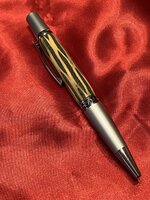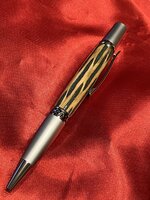Thank you Markus. It was a learning experience for sure. I picked up a few things along the way that will make other projects easier.
Inlay with crushed stone can be both very frustrating and a lot of fun to experiment with but the stone density really comes into play. Then mix that density with glue and it can be even more of a head scratcher sometimes. Mixing materials can be extremely fun to get matches you wouldn't have thought of.
I used, what I thought was anyway, green limestone on a black walnut bowl as a filler because the color popped against the walnut grain. Turns out it wasn't limestone but lamproite lapilli tuff, a type of volcanic rock that is unique to where I got it and is typically between a 6-7 on Mohs scale rather than the 2-4 limestone is. The moment my HSS tools touched this stuff they reverted to butter knife dullness and/or chipped. Had to use fresh carbide to shape it, extremely frustrating. It chewed up sandpaper as well.
The lapilli tuff is in powder form, grinding the rocks down was easy, but once solidified with thin CA it got really, really hard. It wasn't much fun reshaping my HSS tools but lesson learned. I have a LOT of this stuff at my house and I now know to use it more effectively as well.
All that to say, know the stones you are working with. Color is essential to getting the look you want but know the density and how that can pair with woods you are using as well. Have fun with it, I did even with the frustrations and learned a lot. If you gather stones for use just be mindful of them and do your research. I really enjoy mixing mediums even with the frustrations that come with doing it.


